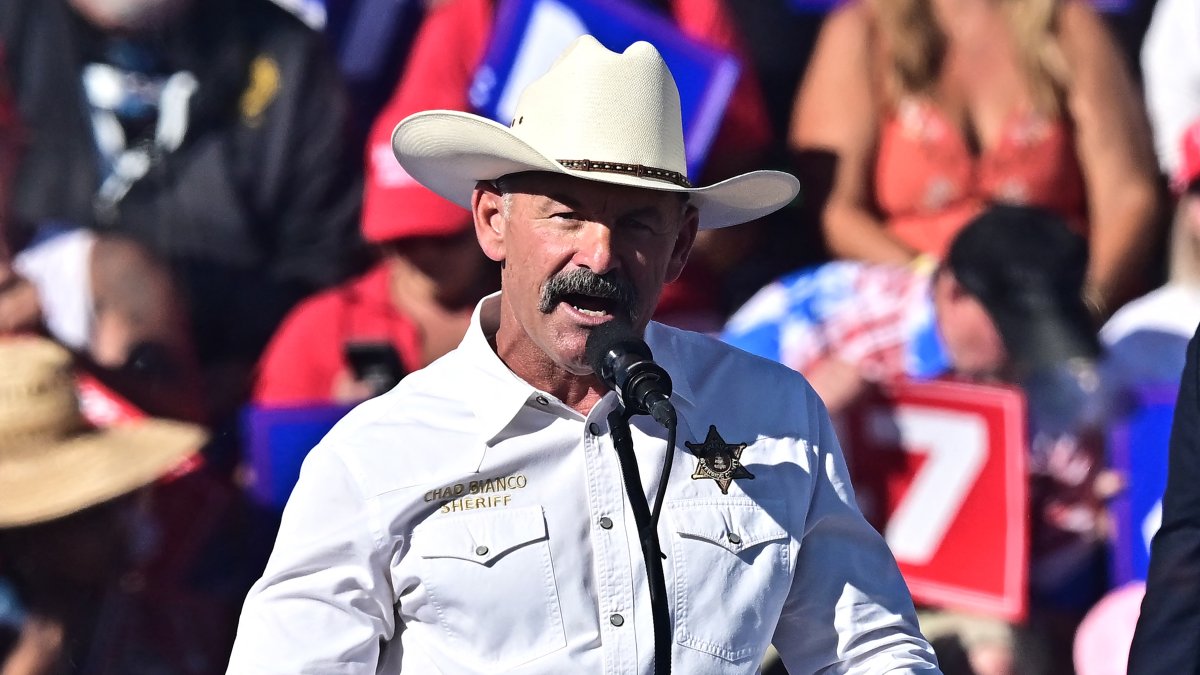Local News
Measure G seeks to expand Los Angeles Board of Supervisors – NBC Los Angeles

[ad_1]
The Los Angeles County Board of Supervisors seldom experiences divisiveness or contention.
But the powerful board run by five women for each of the five districts across the biggest county in the nation is now split over whether to expand its own agency to have more elected board members. And two opposite sides are actively campaigning for or against Measure G.
What would Measure G do?
If the majority of Los Angeles County voters say “yes” on Measure G, they would allow the county to amend its charter to increase the total number of supervisors to nine, instead of the current five.
If passed, the county would also create a county executive, who would essentially become “the mayor of the county,” who would be selected by LA County voters.
Measure G also seeks to establish an ethics commission and a legislative analyst, which would review possible policies for the county.
3 vs. 2
While Supervisors Lindsey Horvath, Janice Hahn and Hilda Solis are supporting Measure G, Supervisors Holly Mitchell and Kathryn Barger are against it.
Why supporters want Measure G
- More representation:
- Those who want to expand the Board say Los Angeles County is too massive and diverse to be represented by just five people.
- Supervisors Horvath, who represents the third district, which includes LA’s Westside and the San Fernando Valley, argues county governance reform is long overdue.
- “The last time the county government changed was back in 1912 when there were more cows than people in this county,” Horvath said. “We need to change our government to make it responsive to 21st century needs.”
- More diversity:
- Supporters use Supervisor Hilda Solis as an example for why the county board needs to be expanded: While nearly half of LA County’s population is Hispanic, Solis is the lone Latina member of the board.
- By having more seats at the table and more voices to reflect the diverse county, there will be more policies that could serve and represent different areas, according to Horvath and other supporters.
- Mayor of Los Angeles County
- In addition to more board members, Measure G seeks to establish a county executive, who would be like a county mayor.
- Instead of the current Los Angeles County CEO who is appointed by the board, Measure G would make that position an elected office, which would force the county’s budget process more transparent, and whoever drafting the budget would be more accountable to the people of LA, supporters argue.
What opponents say about Measure G
- Giving too much power to one person
- Opponents say if the position of a county executive is created, the person would have no term limits while overseeing the county with the authority to hire and fire county department heads.
- This mayor of the county would also have full control over the county’s budget with no veto power over the board, according to opponents.
- “It completely alters the balance of power between either five or nine or whatever number of board of supervisors, and this singular person who would be responsible for all 10 million Angelenos,” said Supervisor Holly Mitchell during an interview with NBC4’s NewsConference.
- Supervisor Kathryn Barger also called Measure G is a “Trojan horse” to consolidate all decision-making power into one position.
- Too costly
- While Measure G supporters say that the expansion of the county government would not cost taxpayers, opponents do not buy the argument.
- Mitchell says all the costs of increasing the number of board districts and creating the county mayor position would come from the existing county budget.
- “I don’t know how you set up this brand-new infrastructure of a county-wide CEO, add four new supervisors, plus their staffs and not think it’s going to cost LA County residents money,” Mitchell said.
- Stepchildren of LA County
- Opponents argue those who live in the unincorporated areas of Los Angeles County would become more disenfranchised under Measure G.
- As the pie of the LA County budget and resources are split into more slices – more districts and more decision-makers – the board would be more stifled to provide municipal services in the incorporated neighborhoods, opponents claim.
- “There’s a reason why East LA was fighting for cityhood, and why the San Fernando Valley is frustrated and feels like they’re not heard by the city of LA. This is not going to change that. This is going to make it worse,” Supervisor Barger said.
While Mitchell and Barger oppose Measure G, Mitchell said she supports the idea of increasing the number of board members, and Barger said she supports the notion of creating an ethics commision.
[ad_2]
Source link
Local News
How the homeless can vote in Los Angeles County and across California – NBC Los Angeles

[ad_1]
Latinos, women and independents are among the voting blocks often discussed during elections.
One woman tells the NBC4 I-Team it is time to consider the homeless, a group she was once a part of.
The last count found more than 75,000 people are homeless in Los Angeles County and many of them may not realize that they can register to vote, including at county shelters and online.
“The main thing I feel for any homeless person, is you have to learn to become vocal, you know? That’s why we are invisible, because a lot of us tend to be so embarrassed, we don’t want to reach out for help,” Justice Butler said.
The 65-year-old former radio disc jockey says she found herself homeless at various times in her life, from her hometown of Houston to Los Angeles. She now lives in a studio apartment near McArthur Park.
One thing that never waned was her desire to be part of the voting process.
“It means a lot every year, because the first time I’m voting, and I’m teary-eyed because of the people before me, and I’ve really learned to connect to my history,” Butler said. “They died and fought for this right to vote.”
Butler registered to vote while at a Los Angeles city shelter.
“When I went into the shelter on Skid Row, they gave me all this paperwork to fill out, and one of it was a voter registration card,” she said.
Her story is not unique.
California law allows an unhoused or homeless voter to participate in the election, said Dean Logan, who oversees the Los Angeles County Registrar-Recorder/County Clerk.
“They can register to vote, they can list the cross street where they spend the most of their time, where they lay their head at night,” Logan said.
“They can list the shelter where they’re staying for residents’ purposes that ensures they get the most localized ballot that’s effective for them,” he added.
Logan tells the NBC4 I-Team, currently there are about 800 voters registered with an intersection address and then another approximately 5,500 voters who registered with a shelter, a church or similar place that provides services.
Still there is the fact that every active registered voter in California receives a vote by mail ballot.
“So you can list a mailing address. So a lot of those voters may list even a Department of Social Services address where they’re receiving information about their benefits or they can use a shelter address or a PO box to receive the voting materials,” Logan said.
He says the fail-safe method remains the in-person vote centers, including mobile ones that the county sends to different neighborhoods.
“We utilize that program to also go to homelessness encampments that are in North County or out in Long Beach or areas like that to ensure that we have access for those voters,” he said.
The need goes beyond the homeless population.
“This is a particular issue in this election because we know that there are a group of citizens who through the end of rent control after the pandemic have been displaced from their homes and may not receive their voting materials because they’re dealing with trying to find a new home or a new place to stay,” Logan said.
Butler says she is battling a debilitating lung disease and is focused on issues that matter to her this election.
“It’s about somebody having a plan for healthcare,” she said.
Her message to others, no matter where they live is, is to vote.
“We got to go out to vote,” she said. “This time, we got to go out and vote, y’all, real.”
Vote by mail ballots have been mailed out. Some of the dozens of in-person vote centers in Los Angeles County will open as soon as 11 days before election day and people can vote at any location, even registering on site.
[ad_2]
Source link
Local News
Dodgers can’t overcome early six-run deficit in 7-3 loss to Mets in Game 2, NLCS even at one game apiece – NBC Los Angeles

[ad_1]
October baseball is infamous for its unscripted nature. Just when you think you can predict the outcome, a literal curveball gets thrown at you, flipping the script, turning everything topsy-turvy.
The Los Angeles Dodgers threw a bullpen game with their season on the line in Game 4 of the NLDS against the San Diego Padres.
Pundits, analysts, and experts alike all said it would be the end of the 2024 Dodgers. Instead, eight different relievers combined for a shutout, extending their season and their scoreless inning streak.
Jack Flaherty and the bullpen threw another shutout in Game 1 of the NLCS on Sunday to tie the MLB record of 33 consecutive scoreless innings in the postseason. So another bullpen game in Game 2 with the same relievers lined up should reproduce the same results, right?
Wrong.
Francisco Lindor snapped the scoreless streak with a leadoff homer in the first, and Mark Vientos broke the game open with a grand slam in the second, and the New York Mets defeated the Dodgers 7-3 in Game 2 to even the best-of-seven NLCS at one game apiece.
“Everything is great when it works well and guys are throwing up zeros, but you’re still facing really good ball clubs,” said Dodgers’ manager Dave Roberts of the bullpen game in Game 4 of the NLDS compared to Game 2 of the NLCS. “And there is a margin that you have to guard against and kind of really appreciate the cost of the next games, and not forgetting that this isn’t a winner-take-all game. It’s not a three-game series.”
Ironically, everyone in the extended baseball multiverse spent the last 24 hours praising the Dodgers pitching staff and wondering when or if they would allow another run.
Flaherty said the pitchers were “feeding off each other,” after Game 1. On Monday they got eaten alive by the “OMG” Mets’ hitters.
Lindor, likely the runner-up for MVP in the National League to Dodgers’ designated hitter Shohei Ohtani, hit the Mets sixth leadoff homer of the season, and first in the playoffs since Curtis Granderson in Game 5 of the 2015 World Series, when he crushed a cutter from opener Ryan Brasier sending the ball soaring into the New York bullpen for a 1-0 lead.
LEADOFF LINDOR LASER 💥 #NLCS pic.twitter.com/nDvDghuYti
— MLB (@MLB) October 14, 2024
Los Angeles went to right-hander Landon Knack for length, but instead of keeping the game close, he opened the flood gates, surrendering five runs in the second inning, including a back-breaking grand slam on the ninth pitch he threw to Vientos.
MARK VIENTOS GRAND SLAM
THE @METS ARE RAKING IN LA 🤯 pic.twitter.com/DIQYRNusVa
— MLB (@MLB) October 14, 2024
“I really didn’t have a feel for things. I just wasn’t sharp today,” said Knack of what happened in the second inning. “I wasn’t able to execute pitches the way I normally do. I wasn’t able to put guys away. I kept leaving things middle.”
From that moment on, nothing happened on Monday afternoon that echoed anything that preceded it. The Dodgers scorching hot offense, that had produced 19 runs over their last three games, went dormant. The dominant pitching staff was ineffective and subordinate.
Ohtani, who was 2-for-4 with two RBI and two runs scored in Game 1 was hitless with two strikeouts in Game 2.
“I thought he didn’t look comfortable versus Manaea,” said Dave Roberts of what he saw from Ohtani at the plate today. “The heater is away. You can see he was just kind of trying to keep the ball away from Shohei.”
Sean Manaea, who entered the game with nearly an 8.00 ERA against the Dodgers in his career, silenced the most-lethal lineup in the Majors for the better part of five innings.
“He’s a really good pitcher,” said Mookie Betts of Manaea on Monday. “He’s been pitching really well lately and has a lot of confidence. He threw the ball well again today. We lost. It sucks. I don’t think anyone here was expecting them to roll over. We have to turn the page and prepare for Game 3 now.”
Manaea, who changed his arm angle in the offseason, delivering his best season since 2019 with the Oakland Athletics, allowed three runs (two earned), on two hits with four walks and seven strikeouts in five innings of work.
Sean Manaea revamped his delivery to throw from a lower arm angle.
It seems to be working 👀 pic.twitter.com/TR49LsfJYu
— MLB (@MLB) October 14, 2024
Maybe it was the early start time that did the Dodgers in. The Mets, who are still on Eastern Standard Time are accustomed to afternoon starts. Los Angeles hasn’t had one since the final game of the regular season on September 29th.
The Dodgers have spent the past decade monopolizing the Majors with a businesslike attitude. Stoic and forceful, less emotion, and more determination than their counterparts, they looked lackadaisical and lost in Game 2, like the drowsy sleeper who keeps hitting snooze on their alarm clock.
It took five innings for the Dodgers to finally awaken from their slumber. Max Muncy put the boys in blue on the board with a solo shot in the fifth inning, his 12th career postseason homer, tied for second on the Dodgers all-time list.
Max Muncy puts the @Dodgers on the board with a solo shot #NLCS pic.twitter.com/bTVXB5B81P
— MLB (@MLB) October 14, 2024
Los Angeles cut the lead in half thanks to a pair of walks and some bad defense by the Mets.
Tommy Edman drove in two runs when a ball bounced off the glove of first baseman Pete Alonso, but the rally ended when Enrique Hernández hit into a double-play with the bases loaded two batters later.
The @Mets get a HUGE double play to get out of the jam! #NLCS pic.twitter.com/gRxJvnxMru
— MLB (@MLB) October 14, 2024
Hernández had another opportunity to tie the game with runners on second and third in the bottom of the eighth, but he popped out to shallow right field to end the inning.
The Dodgers were 1-for-9 with runners in scoring position in Game 2 and left a total of ten runners on base in the loss.
“We’re never out of the fight,” said Dodgers’ catcher Will Smith of the missed opportunities.. “We were one big swing away from tying the game or taking the lead. As long as we keep giving ourselves opportunities like that we’re going to be okay.”
The Dodgers better sound the alarm when they head to Citi Field on Wednesday for Game 3, or they will be in danger of falling behind in this series. That’s not something they want to do against the team that had the most ninth inning comebacks in baseball this season.
Before Game 1 of the series, Muncy said his team needed to keep the fire and intensity that allowed them to win back-to-back elimination games to advance past the powerful Padres. But instead of fire and intensity, it was lethargy and fragility on display in Game 2.
The Mets had much better at-bats than the Dodgers, saw more pitches, showed more fight, and overall looked like the better team on the diamond. Oh, what a difference a day makes.
Momentum is only as good as the next day’s starting pitcher, and the Dodgers didn’t have one.
Their starting rotation is in shambles, injured beyond recognition, with only one pitcher, Yoshinobu Yamamoto, still standing from the Opening Day rotation, and even he missed nearly three months of the season with a rotator cuff injury.
Now the Dodgers will turn to the inconsistent, but battle-tested Walker Buehler in Game 3. Coming off his second Tommy John surgery, Buehler was 1-6 with a 5.38 ERA in 16 games this season. He allowed six runs in the second inning against San Diego in Game 3 of the NLDS. Manager Dave Roberts believes in him and is banking on his past history of big game performances.
“I like Walker on the road,” said Roberts. “I talked to Walker yesterday, and he’s obviously never lacked for confidence, but he’s in a good place physically, and he certainly lives for the big moments. What better way to change the bad taste that you had in the regular season for him to have a dominant postseason, and he’s on a heater right now.”
Whether it’s a heater or a luke-warmer, however it looks, the Dodgers need Buehler to deliver a gem in Game 3. If so, they’re back on-line with Yamamoto going in Game 4 and Flaherty on regular rest in Game 5.
It’s funny how fast things can change in a playoff series. 24 hours ago, the Dodgers looked unbeatable, now they’ve lost home-field advantage and their pitching staff has been quelled. But tomorrow is another day, and another opportunity to flip the script. The rest of this series is still unwritten.
Game 3 of the best-of-seven NLCS between the Mets and Dodgers is scheduled for 5:08 PM PT on Wednesday, October 16th at Citi Field in Queens, NY. The game will air live on FS1.
[ad_2]
Source link
Local News
Riverside County sheriff – NBC Los Angeles

[ad_1]
Riverside County Sheriff Chad Bianco said Monday he stands by his comments over the weekend when he said his deputies may have prevented a third assassination attempt on former President Donald Trump, though a federal law enforcement source told NBC News there’s no indication that there was an attempt to assassinate the former president.
Deputies arrested 49-year-old Vem Miller of Nevada on state weapons charges a quarter mile from the rally. The arrest in Coachella, California, took place before the former president arrived.
“We do know that he showed up with multiple IDs, an unlicensed, unregistered vehicle with fake plates and weapons and ammunition,” Sheriff Bianco said. “In the end ,we found the person with all those monstrous red flags and we were able to arrest him on weapons charges and get him away from the facility before the president got there.”
Bianco’s comments come one day after his weekend press conference where he said he believed another assassination attempt on Trump had been prevented.
But on Monday we also heard from Miller, who is now out of jail after posting bond.
“I am releasing this statement because of the false information that is currently being released,” Miller said in a video shared on Rumble.
In the video, Miller shared that he’s a longtime supporter of former President Trump.
“Since 2000, I’ve been involved in the Republican Party in Nevada,” Miller said. “I am a Trump caucus captain, I have collected votes for Donald Trump, and I’m also a Trump team leader.”
NBC News was not able to verify Miller’s claim that he worked as a Trump caucus captain or a Trump team leader and that he was invited to the rally.
He said that he was in Coachella working as a journalist for the America Happens Network and always carries guns with him.
“In the trunk of my car I carry two firearms: One is a glock, one is a shotgun, and these two firearms that I carry for me are simply for protection,” he added.
Bianco wasn’t backing down.
“If he wants to say he was an innocent victim, then he also has to say how dumb it was to come out to believe that he could do all of those and try to get into that event, with guns,” Bianco said. “I don’t care if he’s a supporter of President Trump.”
“I’m very proud of my deputies and everything that they did there,” Bianco said. “We’re not making up anything that he did, we just caught him.”
[ad_2]
Source link
-

 News10 months ago
News10 months ago6 Ways To Attract a Rich Girl of Your Dream
-

 Finance9 months ago
Finance9 months agoWhich credit card is best for small businesses?
-

 Finance9 months ago
Finance9 months agoBest Business Credit Cards With 0% APR – February 2024
-

 Finance9 months ago
Finance9 months agoHow To Apply For A Chase Business Credit Card
-

 Finance11 months ago
Finance11 months agoLowe’s Credit Card: New Discounts on Lowe’s Purchases
-

 Finance9 months ago
Finance9 months agoLimited Time: Sign up for Chase Freedom Unlimited for a Year of Unlimited Cash Back!
-

 Entertainment11 months ago
Entertainment11 months agoNetflix Schedule January 2024
-

 Tech11 months ago
Tech11 months agoApple Vision Pro: $3,499 headset finally has a release date








